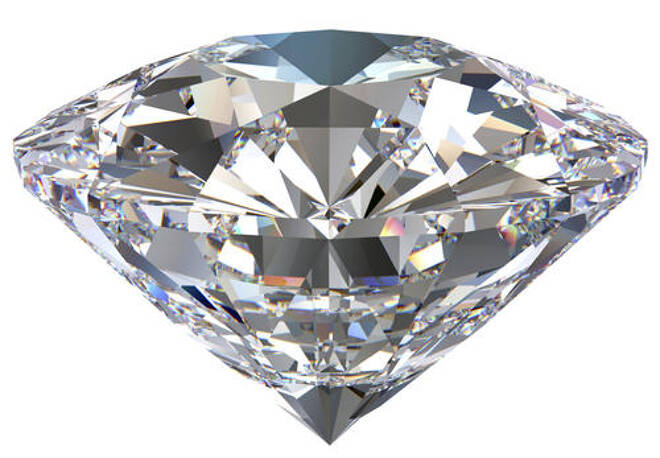Advertisement
Advertisement
Can You Trade Diamonds Online?
By:
Diamonds Are A Girls Best Friend is probably one of the most well-known movie quotes but it doesn’t hold true in the world of investing. Diamonds shine
Diamonds Are A Girls Best Friend is probably one of the most well-known movie quotes but it doesn’t hold true in the world of investing. Diamonds shine and glitter and they go up in value if you are a dealer but when it comes to buying diamonds for an investment or trading in diamonds, remember a trader’s best friend is liquidity. Just because a value is assigned to an asset, that value is only accurate at time of sale. Owning something of great value that you cannot turn into cash means that you have nothing.
Add this to the fact that every diamond is unique and that prices of diamonds are a huge secret, dealer to dealer there seems to be a huge significant variance and since there is a virtual endless supply the only way you can turn your diamonds or other precious gems into cash is to sell them below market to a willing dealer or to look for a retail buyer.
This is the same as in the antique market and the art market. Dealers are secretive about pricing and when they look at “grandma” antique bureau, it becomes just a piece of used furniture but once they put in their store is a priceless antique.
The sector is notoriously for its lack of transparency, making it tough for investors to judge risk factors and analyze profit opportunities. Getting accurate, up to date pricing isn’t always easy, which further complicates investment decisions. That said, there’s also an abundance of opportunity for diamond investors, especially as prices lag in 2015.
Now with all this said the question is “Is there a way to invest in diamonds, such as online contracts or ETFs. investing in diamonds is never straightforward, even when the stones do exist – mainly because valuing them is so tricky. Unlike other precious commodities such as gold, the sheer variety of individual rocks rules out any simple cost-by-ounce pricing mechanism. The basic valuation template boils down to the four Cs – Carat (weight), Color, Clarity and Cut. But there’s plenty of room for subjective interpretation.
Unlike gold, you can’t just walk into a diamond retailer or buyer and get the spot price you saw today on diamond prices. What buyers are looking for is a gemstone’s quality and the cash a buyer is willing to pay, and those two subjective factors that can hinder you from getting your best sales price.
Like a car, a diamond is a depreciating asset since it loses a large portion of its value the second you buy it. Think about gold and silver. The market for them is very liquid and fungible since you can store coins, sell them at any time or even trade them later on. During that time frame they might even appreciate and provide a hedge against inflation.
Given the level of knowledge involved, some reckon that buying diamonds is a sucker’s game unless you have real expertise – though it’s worth noting that the first rule of buying is to avoid getting shafted by jewelers’ mark-ups. If you want to get a feel for prices, check out the largest online dealer, Rapnet.com.
Because of the difficulty in pricing diamonds, ETFs and mutual funds based on the value of the gemstone have remained elusive. However, there are two prominent initiatives for ETFs, Golan says, from Index IQ and GemShares. Both companies have applications under review with the SEC.
The way the ETFs would work, Golan says, is the companies would buy and store physical diamonds, probably 1-carat, round white stones, since those held their value during the 2008 recession and are more readily traded. Shares would be issued to investors and an index created to track the changes in value within the wholesale market.
There are, though, other ways to invest. Because of the difficulty in establishing prices, vehicles like Exchange Traded Funds (common in the gold market) are rare in gems and anyway unregulated. But funds are springing up to track the fortunes of diamond miners and associated companies. The US-based manager PureFunds, for instance, recently launched what it claims is the first “pure-play” diamond industry ETF.
LinGOLD.com have attempted to broaden the market by trading in “diamond fractions rather than entire stones”. Then, of course, you could always check out individual miners, such as London-listed Petra Diamonds, which has been making the running in terms of exceptional finds of late.
Novel Diamond Private Equity Fund LLC, based in Chicago, is a private equity fund that invests in the rare gem market. The absolute return fund, which has a minimum investment of $100,000, uses colored diamonds as its underlying product, says Alan Landau, who runs the trading out of Hong Kong. He notes that white diamond prices might be more volatile, but colored diamonds are more valuable. For example, where a flawless white diamond might be worth $30,000 per carat, a flawless vivid pink diamond could sell for $1 million per carat and a vivid red for $2 million per carat, and those prices have continued to climb.
Until the Securities and Exchange Commission approves such a fund or ETF, U.S. investors are largely limited to buying and selling physical gems, typically through a dealer. But whether considering a fund, ETF or physical ownership, “it’s a sucker’s bet” to get involved in the diamond trade unless you know what you’re doing, according to Martin Rapaport, chairman of Rapaport Group.
About the Author
Barry Normanauthor
Latest news and analysis
Advertisement
